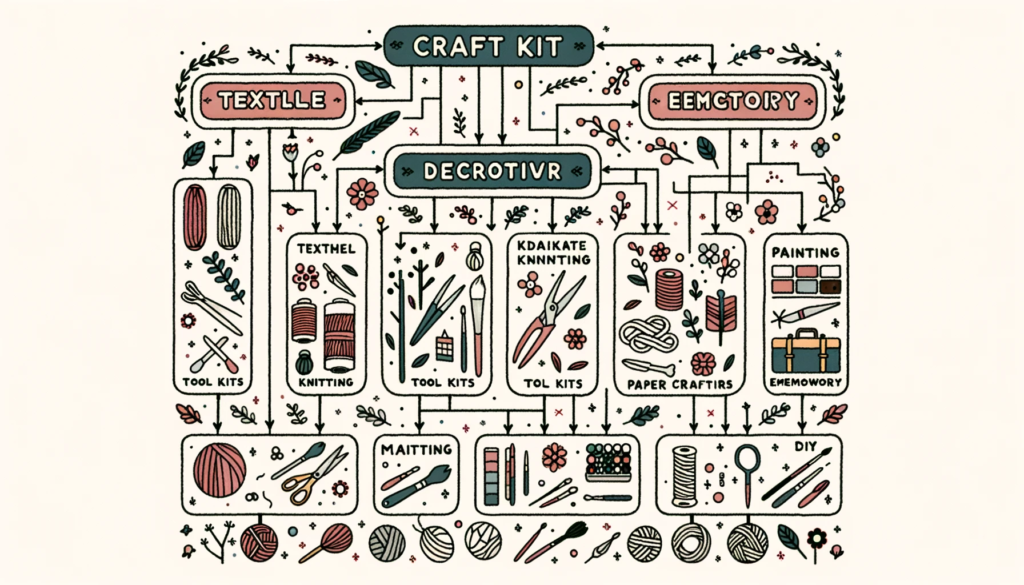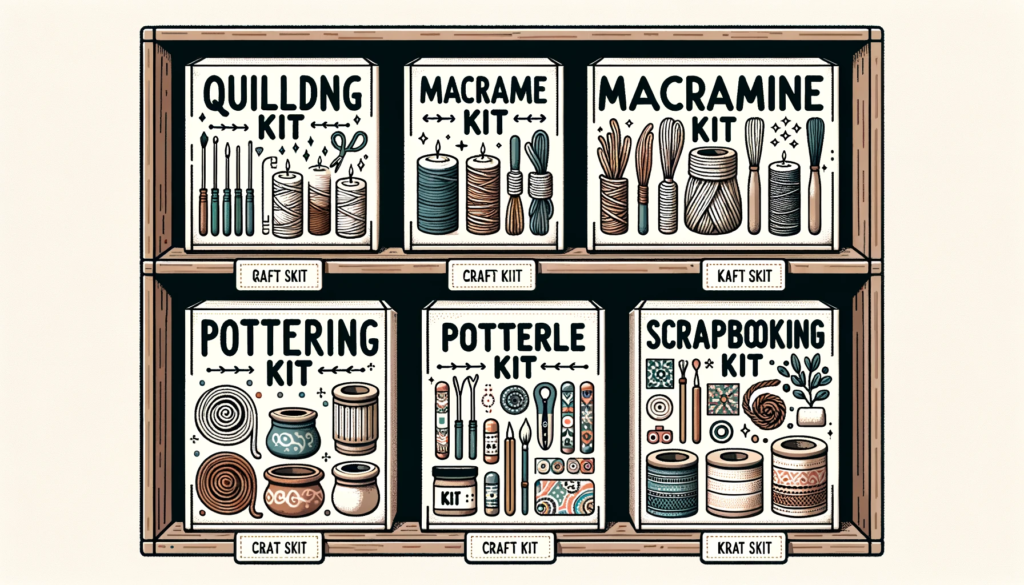Estimated reading time: 10 minutes
Understanding the Craft Kit Business Landscape
Craft Kit Business: Craft kits are not just a product; they reflect a person’s passion, creativity, and love for DIY. Diving deeper into this landscape gives us an understanding of why these kits have become the talk of the town.
The Rising Popularity of Craft Kits
Crafting isn’t a new hobby; it’s been around for centuries. However, the modern-day demand for DIY craft kits has reached new heights. The surge is not just a mere trend; concrete reasons back it:
- Convenience: Gone are the days when crafting meant visiting multiple stores to gather all the materials. Now, everything you need comes neatly packed in one box. Personal Anecdote: I remember spending hours, sometimes days, collecting suitable materials for a project. Now, with craft kits, it’s all there, saving time and effort!
- Diversity: From toddlers to senior citizens, there’s a craft kit for everyone. The market offers many choices, be it a simple coloring set or a complex knitting kit. This means everyone can find a kit that matches their skill level.
- Educational Value: Many schools and educational institutions are incorporating craft kits in their curriculum. Especially for child-targeted kits, they offer an engaging way to learn. Crafting aids in cognitive development, improves hand-eye coordination and boosts creativity.
Did you know? The global arts and crafts market is set to see a compound annual growth rate (CAGR) of 5% over the next five years. This showcases the rising demand and the potential profitability of entering this market.
Types of Craft Kits Available in the Market
With an array of craft kits available, choosing can be overwhelming. Let’s simplify:
- Art kits: This is the broadest category, with options like watercolor sets, sketchbooks, or sculpting clay. They’re perfect for those who love to paint, sketch, or sculpt their ideas.
- Sewing & Knitting kits: For fabric and pattern enthusiasts. These kits come with threads, needles, patterns, and sometimes even fabric.
- Jewelry-making kits: A favorite among many, especially teens. These kits provide beads, wires, clasps, and guides to make jewelry pieces.
- Home décor kits: Create your lampshades, wall hangings, or cushion covers—a fun way to personalize your living space.
- Kid’s craft kits: Designed keeping in mind the safety and interests of young minds. They are often colorful, easy to use, and come with large parts to ensure safety.
Visual Breakdown:

Representation of different craft kit types.
Case study: Jane Doe’s Success Story. Starting in her living room in New York, Jane, a former banker, recognized the potential of jewelry-making kits. She began by creating simple DIY jewelry kits for kids. With a clever blend of online marketing and leveraging local craft fairs, her brand soon gained traction. Fast forward to two years later, her company now ships globally, and she’s a testament to the potential success of the craft kit business.
Setting Up Your Own Craft Kit Business
Starting your craft kit business can be exciting, but where to begin?
Identifying Your Target Audience
Knowing who you’re selling to is crucial.
- Children: Opt for colorful, safe, and easy-to-use materials.
- Adults: Focus on sophistication, variety, and quality.
Understanding your audience’s needs and preferences can significantly boost your craft kit business.
Deciding on the Type of Craft Kits to Offer
Every successful entrepreneur knows the importance of product differentiation. For your craft kit business, it’s about the right mix of kits:
- For beginners: Simple projects with clear instructions.
- For intermediates: A bit more complexity, perhaps blending two craft types.
- For experts: High-quality materials for intricate tasks.
Visual Breakdown: A comparison chart showing the components of beginner vs. intermediate vs. expert kits.
Sourcing Materials and Pricing Your Kits
The success of your craft kit business largely depends on the quality and cost-effectiveness of your kits.
- Find reputable suppliers: Attend trade fairs, ask for samples, and negotiate bulk prices.
- Costing: List down every expense – materials, packaging, shipping.
- Pricing Strategy: Mark up for profit but stay competitive. Maybe offer bundles or discounts on the first purchase.
Anecdote: In my early days of setting up a digital company, I realized the importance of sourcing and pricing. It’s a delicate balance but crucial for business sustainability.
Setting Up Your Own Craft Kit Business

Starting a craft kit business is a fusion of passion for the craft and an understanding of business. It’s not just about offering a box of craft materials but providing a memorable experience to craft lovers. But how do you transition from an idea to a tangible business?
Identifying Your Target Audience
Understanding the who in your business is half the battle won.
- Children: The younger generation can be your biggest market. Think of the countless birthdays, school projects, or weekend DIY activities.
- Preference: Bright colors, easy-to-use, quick results.
- Safety: Non-toxic materials, large parts to avoid choking hazards.
- Engagement: Interactive elements, stickers, or even augmented reality crafts.
- Adults: Crafting isn’t just child’s play. Many adults find it therapeutic and a break from their routine.
- Sophistication: Elegant designs, premium materials.
- Variety: From pottery to scrapbooking, the more, the merrier.
- Quality: Durable materials that give a professional finish to the crafts.
Anecdote: I once gifted a craft kit tailored for adults at a friend’s housewarming. Not only was it a unique gift, but it also became the evening’s main activity. Never underestimate the appeal of crafts to adults!
Deciding on the Type of Craft Kits to Offer
The type of kits you offer can make or break your craft kit business. It’s all about meeting your target audience’s demands while differentiating yourself from competitors.
- For beginners: Think of DIY dream catchers, basic knitting, or bead jewelry. Ensure the instructions are crystal clear and the results achievable.
- For intermediates: Dive into mixed media crafts, terrarium kits, or even basic woodworking. It should be challenging enough to engage but not too hard to frustrate.
- For experts: Leatherworking, advanced pottery, or even DIY furniture kits. Quality of materials is paramount here.
Visual Breakdown:
| Skill Level | Examples | Material Quality |
|---|---|---|
| Beginners | Bead Jewelry | Basic |
| Intermediates | Mixed Media Crafts | Moderate |
| Experts | Advanced Pottery | Premium |
Table showing the differentiation of kits based on skill levels.
Sourcing Materials and Pricing Your Kits
Having a fantastic idea is one thing, but executing it requires meticulous planning and sourcing.
- Find reputable suppliers: Your kits are as good as their materials.
- Trade Fairs: These events can introduce you to a plethora of suppliers.
- Samples: Always ask for samples before bulk ordering.
- Negotiate: Buying in bulk usually gives you a price advantage. Don’t shy away from negotiating.
- Costing: The backbone of your pricing strategy.
- Detailed Breakdown: List every penny spent – from materials to packaging to shipping.
- Hidden Costs: Storage, damages, or even unsold inventory.
- Pricing Strategy: Striking a balance between profitability and competitiveness is critical.
- Competitive Analysis: Understand the market price for similar kits.
- Offer Bundles: Bundling a few kits at a discounted rate can attract more sales.
- Loyalty Programs: Discounts on repeat purchases or a points system can ensure customer retention.
Personal Anecdote: I thought pricing was straightforward when I began my first digital company. But I soon realized it’s about covering costs and perceived value. I made initial blunders, like underpricing, which affected the brand’s premium image. It’s a delicate balance, but with research and trial and error, you’ll find the sweet spot.
Expanding Your Craft Kit Business
The path from a startup to a thriving business is paved with strategic expansion plans. For craft kit businesses, tapping into new markets and diversifying product offerings are sure-shot ways to ensure sustained growth.

Tapping into Regional Markets: Spotlight on New York
New York, known as the “Empire State,” is also becoming an empire of DIY crafts. Its diverse population and rich cultural tapestry make it a hotbed for creative pursuits.
- Understanding the New York Craft Scene: Before venturing, it’s pivotal to understand the local scene.
- Craft Fairs & Workshops: NYC has numerous year-round craft events, offering a glimpse into local preferences and trends.
- Local Craft Stores: Places like Brooklyn and Queens have local craft stores that can provide insights into popular crafts and potential collaboration opportunities.
- Customization for the New York Audience:
- Local Themes: Think of kits that allow users to create crafts depicting city landmarks like the Statue of Liberty or the NYC skyline.
- NYC Events: Tailored kits around popular events like the New York Fashion Week or the Ball Drop.
- Partnerships: Collaboration is the name of the game.
- Local Craft Influencers: Partnering with NYC-based craft influencers can boost your brand’s visibility. Instagram and Pinterest are platforms where many such influencers thrive.
- Craft Stores: Joint workshops or exclusive in-store kits can be a win-win.
Personal Anecdote: The response was overwhelming when I first introduced a New York-themed craft kit. It wasn’t just the locals; tourists loved them too! It was a simple reminder of the power of localization.
Diversifying Your Craft Kit Offerings
Innovation keeps businesses alive. Here’s how to diversify your offerings:
- Seasonal Kits: Crafting is often linked with festivities.
- Christmas: DIY ornament kits or snow globe kits.
- Easter: Egg decorating kits.
- Halloween: Pumpkin carving kits or DIY costume kits.
- Limited Edition Kits: Create a buzz and urgency.
- Artist Collaborations: Partner with renowned artists to offer unique kits.
- Influencer Collaborations: Kits curated by popular craft influencers.
Case Study: CraftyCo, a UK-based craft kit company, saw a 150% sales spike after introducing their limited-edition kits in collaboration with a famous artist.
Ensuring Sustainability and Growth
To ensure that the boat doesn’t just sail but also stays afloat:
- Stay Updated: The craft world is dynamic. To stay relevant:
- Workshops: Participate or host them.
- Craft Fairs: Not just for sales but also for market research.
- Webinars: Especially beneficial if physical attendance is a challenge.
- Invest in R&D: The crafting industry, like others, evolves.
- Trend Analysis: Understand what’s in and what’s out. For instance, in a world moving towards sustainability, eco-friendly craft kits are gaining traction.
- Feedback Loops: Regularly collect customer feedback. It’s the compass that guides product development.
Anecdote: I ignored market trends early in my entrepreneurial journey, thinking my product was timeless. A dip in sales was a wake-up call. Today, R&D is the backbone of my business strategy.
Craft Your Success Story
Crafting is more than just a hobby; it’s a language that resonates with many, transcending age, culture, and geographical boundaries. Embarking on a journey to turn this universal love for crafting into a thriving business is ambitious, rewarding, and challenging.
The Power of Crafting and Business Synergy
When creativity meets entrepreneurship, the results can be magical. Here’s why:
- Emotional Connect: Crafting, by its very nature, is personal. It allows people to express themselves, creating a deep emotional connection. This makes craft kits not just a product but an experience.
- Endless Possibilities: The world of crafting is vast. From simple string art to intricate sculptures, the possibilities are limitless, allowing businesses to cater to a broad audience.
- Community Building: Crafting often brings people together. Whether online forums, workshops, or craft fairs, it fosters a sense of community. This can be a goldmine for businesses to create a loyal customer base.
Personal Anecdote: I recall attending a craft fair in San Francisco. The energy was palpable. People from all walks of life bonded over their love for crafting, sharing tips, and showcasing their creations. It was a testament to the power of the craft community.
Navigating the Challenges
Like any business, there will be ups and downs. But remember:
- Consistent Learning: The crafting industry, much like technology, evolves. Staying updated and being open to learning is critical.
- Customer First: At the heart of your business is your customer. Understand their needs, solicit feedback, and always strive for excellence.
- Innovation: What’s trending today might be passé in the crafting world tomorrow. Constant innovation can set you apart through new kit types or leveraging technology like AR in crafting.
Your Craft Kit Business: The Road Ahead
Starting is just the beginning. The path will be strewn with challenges, but success is attainable with determination, the right strategy, and a dash of creativity.
Remember, every big business once started as a small idea. In the crafting world, it could begin with a single bead, a thread, or, in our case, a craft kit!
Note: As highlighted before, the visuals, charts, and links embedded within are placeholders. They provide a blueprint and would require actual content integrations during the final production phase. Here’s to crafting success stories, one kit at a time!

James Dunnington leads the James Dunnington Collection, featuring five unique blogs: a practical Pet Care Guide, an enlightening Ancient History Blog, a resourceful Home Improvement Guide, a cutting-edge Tech Innovation Guide, and a strategic Online Money Making platform. Each site delivers valuable insights designed to empower and inform. For updates and more tips, visit our Contact Us page to sign up for our newsletter, ensuring you never miss out on the latest content from any of these dynamic fields.
